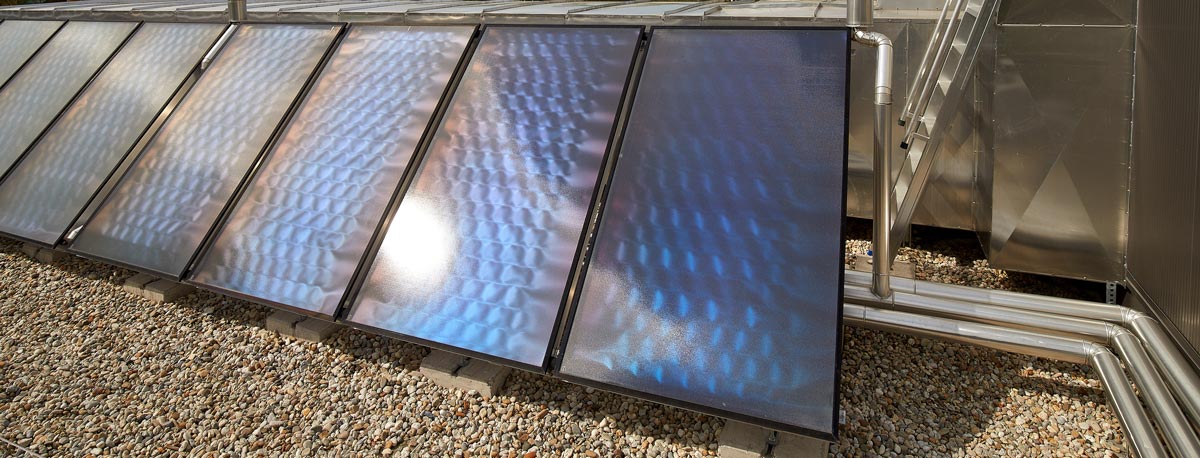Heat from the sun has tremendous potential, since it is available in virtually unlimited quantity and can be integrated satisfactorily both in existing and in future energy systems. At the end of 2011 the total area of solar collectors in place around the world came to 535 million m², with a rated capacity of 375 GWth. In the international ranking Austria comes eighth; in relation to population Austria actually leads the field, with 430 kWth per 1 000 inhabitants, ahead of Cyprus (425 kWth per 1 000 inhabitants) and Israel (377 kWth per 1 000 inhabitants). Source: www.nachhaltigwirtschaften.at/iea_pdf/reports/iea_shc_solar_heat_worldwide_ed2015.pdf
At the end of 2014 the total area of solar collectors in place in Austria came to 5.2 million m2, with a rated capacity of 3.6 GWth. On the basis of the Austrian heat mix , this corresponds to an annual saving of 440 898 t of carbon dioxide emissions. In the field of solar thermal systems Austrian technology is very successful internationally; in 2014 around 82 % of the thermal collectors manufactured here were exported.
Supplying hot water and providing additional heat in single-family houses account for a considerable share of the market for solar thermal applications. Combined facilities to provide additional heat in multi-storey housing, solar district heating, heat from the sun for commercial and industrial applications, and solar facilities for cooling and air-conditioning, are gaining in importance.
However, the European market for solar collectors has (by and large) been shrinking in recent years – this applies to Austria, too. There are various reasons for this: the regulations governing grants have changed, and competition between different renewables is increasing. The main competitors here are heat pumps (both for process water and for heating), pellet heating systems, and photovoltaic to generate electricity resp. heat.
Roadmap for heat from the sun
To avoid any further contraction of this market, strategies are needed for an early turnaround. On behalf of the Federal Ministries for Transport, Innovation and Technology (bmvit), Science, Research and the Economy (bmwfw) and Agriculture, Forestry, Environment and Water Management (BMLFUW), AEE INTEC drew up an Austrian roadmap “Solar heat 2025” in 2014; it contains an analysis of possible scenarios for 2025 and presents options in the areas “Sectoral Activities”, “Research and Development”, “Overall Framework” and “Ancillary Arrangements”.
In close consultation with solar thermal proponents more than a hundred separate measures to boost the relevant technology have been identified. At the national level the strategies are aligned with international recommendations such as those of the European technology platform “Renewable Heating and Cooling”. In the field of solar thermal technologies the following research topics are classified as vital: “Solar Compact Hybrid Systems”, “Solar Active House”, “Solar Heat for Industrial Processes (SHIP)” and “Energy Storage Technologies”.
The main challenge is to reduce the system costs of solar thermal facilities. The aim is to cut the cost of small facilities by up to 60 % and that of large facilities by up to 40 %. To achieve this, components and systems could be simplified, or the product range could be adapted resp. thinned out. Automating yield and quality assurance, and developing smart interfaces and applications and user interfaces matched to specific target groups, have also been identified as constructive actions. The important areas for research are: increasing the heat density of thermal storage units, monovalent heat supply systems, and specific developments in new application sectors (such as combined or hybrid systems, large facilities or applications in grid-based infrastructures). How solar heating develops in future will very largely depend on the business models employed. New approaches to sales and marketing, plus collaboration between individual firms and between sectors, are needed here.
With the support of bmvit and the Climate and Energy Fund a number of pioneering technologies and applications in the field of solar thermal energy are currently being researched and given practical tests. Below we present some of these seminal research projects.
Share